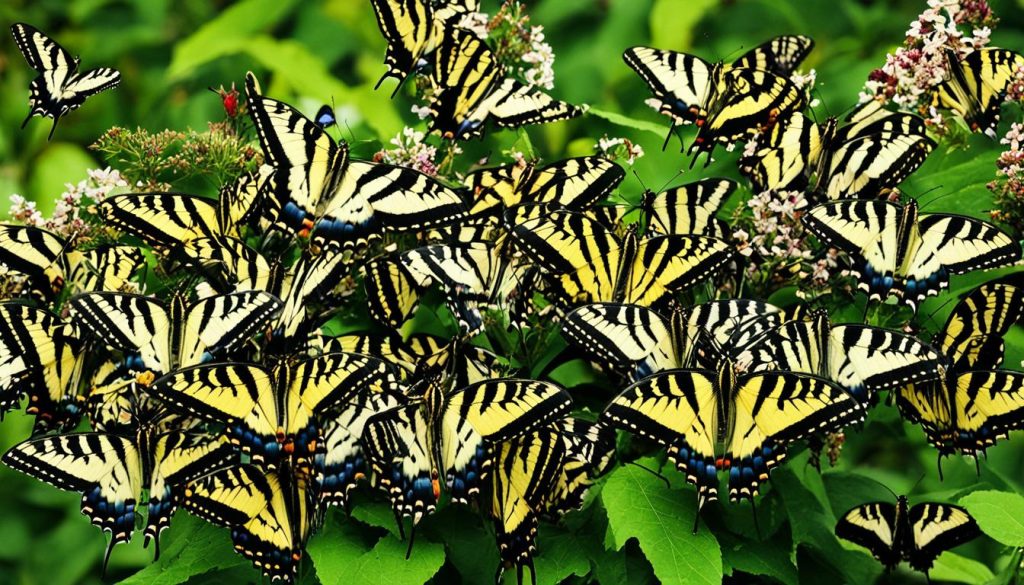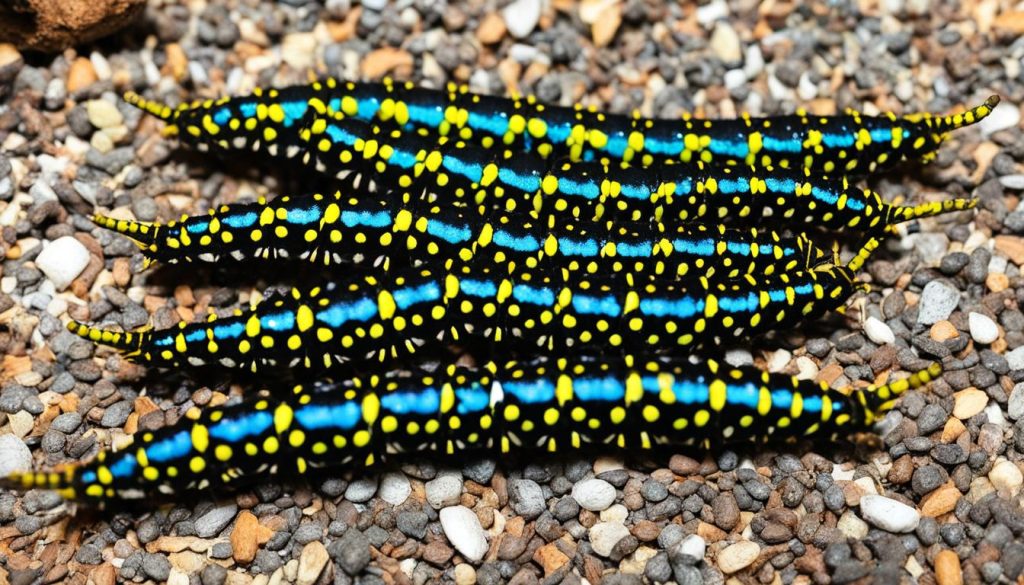Swallowtails are a diverse family of butterflies, with over 500 species found across six continents. While most swallowtails are tropical, there are about 25 species regularly found in North America and Canada. These butterflies are known for their large size, striking colors, and extended tails on their hindwings. Swallowtails are named for their resemblance to swallows in flight. They are a popular sight in backyards and gardens during the warmer months of the year.
Key Takeaways:
- Swallowtails are a diverse family of butterflies with over 500 species worldwide.
- About 25 swallowtail species are found regularly in North America and Canada.
- Swallowtails are known for their large size, striking colors, and extended hindwing tails.
- These butterflies are commonly spotted in backyards and gardens during warmer months.
- Appreciate the beauty of swallowtail species and their unique resemblance to swallows in flight.
The Colorful World of Swallowtail Species
Swallowtail species come in a wide range of vibrant colors, making them a delight to observe. Some of the most colorful species include the zebra swallowtail, which is striped black and white with red accents, and the black swallowtail, which has iridescent blue markings on its hindwings. There are also rare species, such as the papilio natewa, which was recently discovered in Fiji and boasts striking black and white zigzags on its wings. Alongside these rare species, there are also common swallowtails like the Eastern tiger swallowtail, which can be found across North America and is known for its bright yellow color.

Swallowtails not only display stunning hues but also often exhibit intricate patterns on their wings. These vibrant colors and patterns serve multiple purposes, including attracting mates, repelling predators, and blending into their natural habitats. The diverse range of colors in the swallowtail family adds to the overall beauty and visual appeal of these butterflies.
“The colors of the swallowtail species are truly a sight to behold. Their vibrant hues and intricate patterns add a touch of whimsy and wonder to the natural world.” – Entomologist Dr. Emily Carter
While some species may share similar coloration patterns, each swallowtail has its own unique qualities that make it fascinating to study and admire. From the rare and elusive species to the more common varieties found in gardens and parks, these butterflies never fail to captivate with their stunning appearance.
Next, we will explore the various swallowtail species found around the globe, highlighting their distinct characteristics and habitats.
Swallowtail Species Around the Globe
Swallowtail species can be found on every continent except Antarctica. These magnificent butterflies have adapted to various regions and have unique characteristics that make them distinctive in each area. Let’s explore some of the notable swallowtail species across the world.
North America
In North America, you can find several swallowtail species that grace the skies with their vibrant colors. Some of the most common North American swallowtails include:
- Eastern tiger swallowtail
- Western tiger swallowtail
- Black swallowtail
These beautiful butterflies are a familiar sight in gardens and meadows throughout North America, adding a touch of elegance to the landscape.
Europe
Europe is home to its own unique swallowtail species. One of the most iconic and well-known species in Europe is the European swallowtail. With its bright yellow wings adorned with black stripes and blue spots, this butterfly is a true symbol of beauty.
Other European swallowtail species include:
- Scarce swallowtail
- Large white admiral
- Swallowtail (Iberian subspecies)
These European swallowtail species captivate enthusiasts and nature lovers alike with their exquisite patterns and graceful flight.
Asia
Asia is home to a diverse array of swallowtail species, each with its own unique characteristics. Some notable Asian swallowtails include:
- Common rose swallowtail
- Chinese yellow swallowtail
- Lime butterfly
These Asian swallowtails display a remarkable range of colors and patterns, making them a sight to behold in the lush landscapes of Asia.
Africa
Africa is host to several swallowtail species that showcase the beauty of the continent’s diverse ecosystems. One of the prominent African swallowtails is the African giant swallowtail, known for its impressive size and intricate wing patterns.
Other African swallowtails include:
- Citrus swallowtail
- Pure black swallowtail
- Gaudy commodore
These African swallowtails contribute to the rich biodiversity of the continent, enchanting observers with their striking appearance.
Australia
Australia is home to its own unique swallowtail species, many of which boast vibrant colors and eye-catching patterns. One standout species is the Ulysses swallowtail, renowned for its mesmerizing iridescent blue wings.
Other Australian swallowtails include:
- Lurcher swallowtail
- Orchard swallowtail
- Pale triangle swallowtail
Australian swallowtail species add a touch of wonder and splendor to the continent’s diverse landscapes.
No matter the region, swallowtails are a testament to the beauty and diversity of the natural world. Each species offers a unique glimpse into the extraordinary realm of butterflies.
Fascinating Swallowtail Caterpillars
Swallowtail caterpillars are truly remarkable creatures. Not only are they known for their large size, but also for their unique color patterns that make them stand out in the insect world.
One fascinating example is the tiger swallowtail caterpillar. This caterpillar is predominantly green and features two large round spots on its head that cleverly mimic the eyes of a snake. This fascinating adaptation deters potential predators, granting the caterpillar a higher chance of survival.

Another attention-grabbing species is the pipevine swallowtail caterpillar. Its appearance is dark reddish to black, adorned with striking orange spikes. The combination of colors and textures serves as a warning to predators, signaling that this caterpillar is not to be messed with.
The black swallowtail caterpillar is yet another intriguing member of the swallowtail family. Its distinct green body is beautifully accentuated by black stripes, creating an eye-catching pattern as it moves along branches and leaves.
Lastly, we have the giant swallowtail caterpillar with a unique defense mechanism. When small, its smeary black and white pattern closely resembles bird droppings, an effective camouflage that helps it blend in with its surroundings and avoid detection.
These swallowtail caterpillars showcase the incredible diversity and adaptability of these creatures. From mimicry to camouflage, they have evolved fascinating strategies to protect themselves in the wild.
It’s important to note that these caterpillars possess a special defensive organ called an osmeterium. When threatened, they can extend this organ and emit a foul odor that deters predators, further increasing their chances of survival.
| Caterpillar Name | Color | Distinct Features |
|---|---|---|
| Tiger Swallowtail Caterpillar | Green | Snake-like eye spots |
| Pipevine Swallowtail Caterpillar | Dark reddish to black | Orange spikes |
| Black Swallowtail Caterpillar | Green with black stripes | Distinctive pattern |
| Giant Swallowtail Caterpillar | Smeary black and white | Camouflage |
The variety of swallowtail caterpillars showcases the beauty and wonder of nature’s creations. Their striking colors and distinct patterns not only captivate our attention but also provide insights into the fascinating world of insect adaptation and survival.
Host Plants and Habitats for Swallowtails
Swallowtails have specific host plants that their caterpillars rely on for food and habitat. These plants play a crucial role in supporting the lifecycle of these beautiful butterflies. Here are some examples of swallowtail host plants:
Zebra Swallowtail
The zebra swallowtail caterpillar primarily feeds on pawpaw trees (Asimina spp.). These trees are native to North America and provide the perfect habitat for both the caterpillar and the adult butterfly.
Spicebush Swallowtail
The spicebush swallowtail (Papilio troilus) favors spicebush (Lindera spp.) and sassafras (Sassafras albidum) as its host plants. These shrubs are found in the eastern United States and provide essential food and shelter for the caterpillars.
Eastern Tiger Swallowtail
The larvae of the Eastern tiger swallowtail (Papilio glaucus) feed on various tree species. Common host plants include ash (Fraxinus spp.), wild cherry (Prunus avium), and tulip tree (Liriodendron tulipifera). These trees are widespread across North America, providing ample resources for the caterpillars to thrive.
Black Swallowtail
The black swallowtail (Papilio polyxenes) caterpillar has a diverse range of host plants within the parsley family (Apiaceae). Popular choices include parsley (Petroselinum crispum), dill (Anethum graveolens), and fennel (Foeniculum vulgare). These plants are commonly found in gardens and provide the necessary nutrition for the caterpillar’s growth.
By cultivating these swallowtail host plants in your garden or preserving their natural habitats, you can create a welcoming environment for these enchanting butterflies. Offering the right host plants ensures a sustainable population of swallowtails, adding beauty and biodiversity to your surroundings.
Conclusion
Swallowtail butterfly species are an extraordinary part of the natural world, showcasing their beauty through vibrant colors, unique patterns, and graceful flight. Whether it’s the rare and elusive varieties or the more common swallowtails, these butterflies never fail to captivate us with their stunning appearance.
By understanding the habitat needs of swallowtails and providing suitable host plants, we can contribute to the preservation and growth of their populations. Creating gardens that cater to the diverse swallowtail family will not only support these beautiful insects but also bring their enchanting presence into our own outdoor spaces.
Let’s take a moment to appreciate the wonders of these remarkable creatures. Explore the diverse swallowtail butterfly species found across the globe and immerse yourself in their fascinating world. Whether it’s observing their graceful flight or admiring their intricate wing patterns, the beauty of swallowtails will continue to inspire awe and wonder. Safeguarding these magnificent creatures ensures the preservation of their heritage for future generations to treasure.
FAQ
How many species of swallowtails are there?
There are over 500 species of swallowtails found across six continents.
How many swallowtail species are regularly found in North America and Canada?
There are about 25 swallowtail species regularly found in North America and Canada.
What are swallowtails known for?
Swallowtails are known for their large size, striking colors, and extended tails on their hindwings.
Why are they called swallowtails?
They are called swallowtails due to their resemblance to swallows in flight.
What are some of the most colorful swallowtail species?
Some of the most colorful swallowtail species include the zebra swallowtail and the black swallowtail.
Are there any rare swallowtail species?
Yes, there are rare swallowtail species such as the papilio natewa, recently discovered in Fiji.
What are some common swallowtail species in North America?
Some common swallowtail species in North America include the Eastern tiger swallowtail and the Western tiger swallowtail.
What are some swallowtail species found in Europe?
The European swallowtail is a prominent species found in Europe.
What are some swallowtail species found in Asia?
Asia boasts several swallowtail species, such as the common rose swallowtail and the Chinese yellow swallowtail.
What is a prominent swallowtail species in Africa?
The African giant swallowtail is a prominent species found in Africa.
What is a notable swallowtail species in Australia?
The Ulysses swallowtail is known for its vibrant blue coloration and is found in Australia.
What are some unique characteristics of swallowtail caterpillars?
Swallowtail caterpillars are known for their large size and unique color patterns.
What is the defensive organ of swallowtail caterpillars called?
The defensive organ of swallowtail caterpillars is called an osmeterium.
What are some host plants for swallowtail caterpillars?
Host plants for swallowtail caterpillars include pawpaw trees, spicebush, sassafras, ash, wild cherry, tulip tree, and plants in the parsley family.
How can we support swallowtail populations?
We can support swallowtail populations by providing suitable host plants and habitats for them.








